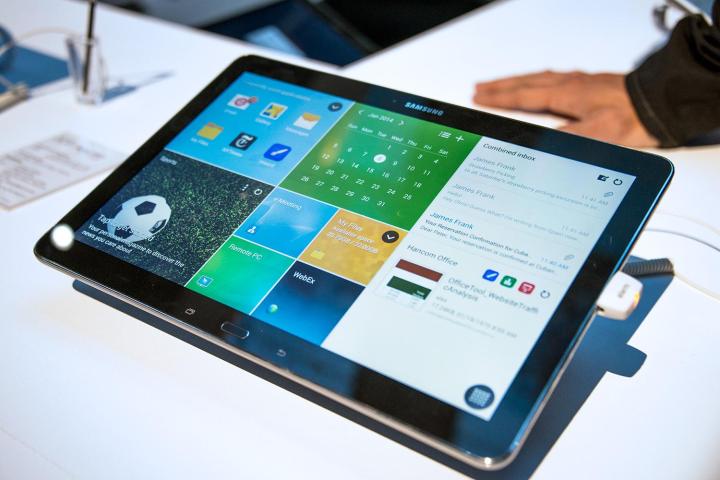
Wait, what?
You heard me. Google’s Android OS may have helped Samsung rise to the top of the phone and tablet world, but not every relationship can last forever. Samsung’s new user “Magazine UX” interface for its Pro line of Galaxy Tab and Note tablets (They come in 8, 10, and 12-inch sizes) is a major step toward de-emphasizing the Google in Android.
With the new UI, Samsung cleverly hides Google’s app store and apps under a pile of new home screens, designed to look like a lovechild between Windows Phone and Flipboard. Instead of looking at a home screen of icons, you browse a grid of giant square and rectangular widgets that you can resize and reform at your whimsy. You can still access your list of apps, but Samsung relegates them to a separate, ugly one-off home screen that you can customize.
Samsung wants to ascend to the same level as Apple, but it needs to move out of Google’s garage first.
Of course, tech savvy users of the Galaxy Pro tablets will figure out how to eliminate Samsung’s new home screens, but they look good, and many will want to use them or never realize they have other options. The trap is that if you use them, you’re effectively only using apps from Samsung. It’s also added in widgets and links to its own App Store, email client, and other Samsung services, but few for anything by Google. You have to go searching for the Google Play Store and other apps.
Virtually no apps you install from Google Play (you know, that app store with 1 million apps) are compatible with Samsung’s new interface – not even if they have big square widgets. Samsung reps told me that even most apps from Samsung’s app store aren’t compatible with the new interface.
With Samsung’s new interface, Google’s typical Android apps feel like the legacy desktop on Windows 8 – out of place. By hiding the old interface, eventually Samsung can swap it out for its own OS (maybe Tizen or Boxee?) and many people may not realize it – the old bait and switch.
Samsung will likely add this new interface to its upcoming Galaxy S5 and other phones this year, forcing developers to begin making apps that will work and look properly on Samsung phones. It even held a developer event (much like Apple, Google, and Microsoft’s annual developer shows) in late 2013, encouraging development specifically for Samsung platforms.
Samsung wants to take the last step and ascend to the same level as Microsoft, Apple, and Google. It wants to own its operating system and sell its own apps, because without full control over its OS, it is stuck following the whims of Google’s Android updates and will never be able to sell as many services and plow forward with new interface and device concepts.
If it eventually severs ties with the Google Play Store, Samsung will effectively mame Android, cutting a huge limb off of Google’s ecosystem. There will be yet another major app store joining the ranks of Amazon’s Appstore, Google Play, and Apple’s App Store, and more strain on developers to customize apps. Without fail, it will make the phone and tablet world a more confusing place for those in the market for a device.
What we don’t know is how long it will take Samsung to make the switch and exactly what it’s planning. Will it continue forking Android, like Amazon does with the Kindle Fire, or will it push forward with a completely new, Samsung operating system? Regardless, Samsung is up to something big. The pieces are moving, and the game is set.
The biggest handset manufacturer in the world is moving away from Google. The question is: will they ever divorce entirely, and how much will this hurt phone buyers looking for apps? If Samsung is smart, this breakup will take a long time.
Editors' Recommendations
- A new Google Pixel Tablet is coming, but it’s not what you think
- A surprise phone just beat the Galaxy S24 Ultra in a big way
- 5 phones you should buy instead of the Samsung Galaxy S24
- A new version of the Samsung Galaxy S24 could be coming soon
- 5 things I want to see in the Samsung Galaxy S25 Ultra




